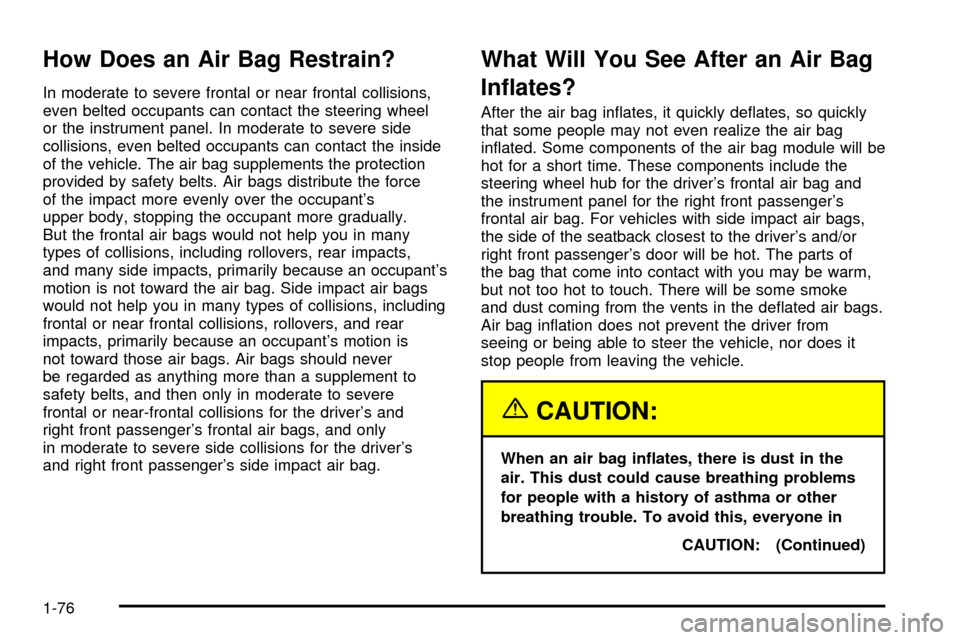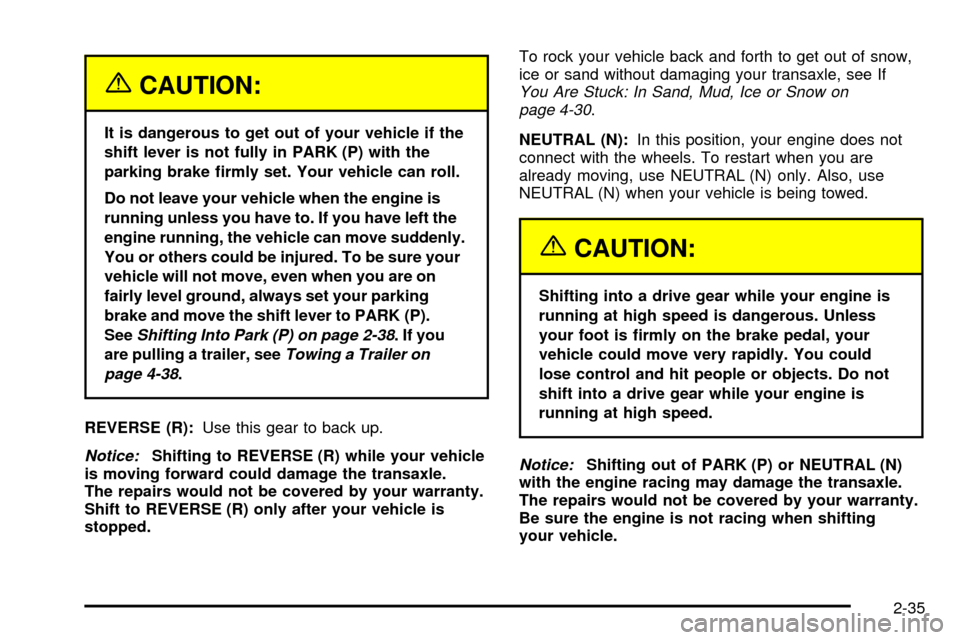tow Oldsmobile Silhouette 2004 s User Guide
[x] Cancel search | Manufacturer: OLDSMOBILE, Model Year: 2004, Model line: Silhouette, Model: Oldsmobile Silhouette 2004Pages: 462, PDF Size: 3.1 MB
Page 64 of 462

An anchor bar for a top strap is located at the rear of
the seat cushion for each second and third row outboard
seating position.The anchor bar for the stowable bench seat is located on
the passenger's side of the crossbar. Use the center
seating position to use the anchor bar properly. If the
convenience center is in the vehicle, you must lift the tray
sill to use the anchor. See
Convenience Center on
page 2-58for more information.
Do not use a child restraint with a top strap in the right
front passenger's position, because there is no place
to anchor the top strap. Third Row (50/50)
Third Row (Stowable Seat)
1-58
Page 82 of 462

How Does an Air Bag Restrain?
In moderate to severe frontal or near frontal collisions,
even belted occupants can contact the steering wheel
or the instrument panel. In moderate to severe side
collisions, even belted occupants can contact the inside
of the vehicle. The air bag supplements the protection
provided by safety belts. Air bags distribute the force
of the impact more evenly over the occupant's
upper body, stopping the occupant more gradually.
But the frontal air bags would not help you in many
types of collisions, including rollovers, rear impacts,
and many side impacts, primarily because an occupant's
motion is not toward the air bag. Side impact air bags
would not help you in many types of collisions, including
frontal or near frontal collisions, rollovers, and rear
impacts, primarily because an occupant's motion is
not toward those air bags. Air bags should never
be regarded as anything more than a supplement to
safety belts, and then only in moderate to severe
frontal or near-frontal collisions for the driver's and
right front passenger's frontal air bags, and only
in moderate to severe side collisions for the driver's
and right front passenger's side impact air bag.
What Will You See After an Air Bag
In¯ates?
After the air bag in¯ates, it quickly de¯ates, so quickly
that some people may not even realize the air bag
in¯ated. Some components of the air bag module will be
hot for a short time. These components include the
steering wheel hub for the driver's frontal air bag and
the instrument panel for the right front passenger's
frontal air bag. For vehicles with side impact air bags,
the side of the seatback closest to the driver's and/or
right front passenger's door will be hot. The parts of
the bag that come into contact with you may be warm,
but not too hot to touch. There will be some smoke
and dust coming from the vents in the de¯ated air bags.
Air bag in¯ation does not prevent the driver from
seeing or being able to steer the vehicle, nor does it
stop people from leaving the vehicle.
{CAUTION:
When an air bag in¯ates, there is dust in the
air. This dust could cause breathing problems
for people with a history of asthma or other
breathing trouble. To avoid this, everyone in
CAUTION: (Continued)
1-76
Page 96 of 462

To unlock the driver's door from the outside with the
key, insert the key and turn it toward the front of
the vehicle. If your vehicle has power door locks, you
may be able to unlock all of the doors and the liftgate by
inserting the key, turning it toward the front of the
vehicle, and holding it there for one second. To lock the
driver's door from the outside with your key, insert
the key and turn it toward the rear of the vehicle. If your
vehicle has power door locks, you may be able to
lock all of the doors when you insert the key and turn it
toward the rear of the vehicle.
From the inside, use the manual or power door locks.
To unlock either front door from the inside, pull back
on the manual lever. To lock either front door from the
inside, push the manual lever forward.
2-10
Page 99 of 462

Sliding Door Delayed Locking
If either sliding door is open when you use the power
door locks to lock the vehicle, the sliding door that
is open will not lock. Normally the last door closed
locking feature will be used to lock the sliding door after
it has been closed.
When the ignition is on or if the last door closed locking
feature has been overridden or programmed to be
off, the sliding door delayed locking feature will lock your
sliding door for you. Three seconds after a sliding
door is closed, all the doors will lock.
Lockout Protection
The lockout protection feature makes it difficult for you
to lock your keys in your vehicle. If the driver's door
is open while the keys are in the ignition, a chime will
sound and you will not be able to use your power
door lock switch to lock the vehicle.
If you don't leave the keys in the ignition or if you use the
manual door lock, you could still lock your keys in your
vehicle. Always remember to take your keys with you.
To turn this feature off or on, see
Vehicle
Personalization on page 2-60.
Leaving Your Vehicle
If you are leaving the vehicle, take your keys, open your
door and set the locks from the inside. Then get out
and close the door.
Dual Sliding Doors
To open either sliding door from outside the vehicle, pull
the handle out and then pull the door toward the rear.
If you slide the door all the way back, the door will rest
in a detent position.
To move the door forward, you must ®rst pull the door
past the open detent position.
The driver's side sliding door is designed to open only
a little if the fuel door is open. If this ever happens,
don't try to force the sliding door. Just close the driver's
side sliding door. Then when the fuel ®ller door is
closed, the driver's side sliding door can be opened
normally.
2-13
Page 106 of 462

{CAUTION:
If your vehicle is facing downward on a steep
grade (15 percent or more), the door may not
stay open and could slam shut, possibly
injuring someone. To make sure the door does
not slam shut, turn on the power sliding door
feature. Then if the door closes, it will close
under the control of the power door system.
If you want to close the power sliding door(s) when the
override switch(es) is turned off, pull the inside or outside
handle or the edge of the door. Move the door about
4 inches (10 cm) toward the closed position and release
it. The door will close completely and latch for you.
To close the power sliding door(s) when the override
switch(es) is turned on, pull the inside or outside handle
and slide the door all the way forward to the latched
position.
2-20
Page 116 of 462

5. The security message will turn off once the key has
been programmed. It may not be apparent that the
security message went on due to how quickly
the key is programmed.
6. Repeat Steps 1 through 4 if additional keys are to
be programmed.
If you are ever driving and the security message comes
on and stays on, you will be able to restart your
engine if you turn it off. Your PASS-Key
žIII system,
however, is not working properly and must be serviced
by your dealer. Your vehicle is not protected by the
PASS-Key
žIII system at this time.
If you lose or damage a PASS-Key
žIII key, see your
dealer or a locksmith who can service PASS-KeyžIII to
have a new key made.
Starting and Operating Your
Vehicle
New Vehicle Break-In
Notice:Your vehicle does not need an elaborate
ªbreak-in.º But it will perform better in the long run
if you follow these guidelines:
·Do not drive at any one speed Ð fast or
slow Ð for the ®rst 500 miles (805 km).
Do not make full-throttle starts.
·Avoid making hard stops for the ®rst
200 miles (322 km) or so. During this time
your new brake linings are not yet broken in.
Hard stops with new linings can mean
premature wear and earlier replacement.
Follow this breaking-in guideline every time
you get new brake linings.
·Do not tow a trailer during break-in.
See
Towing a Trailer on page 4-38for
more information.
2-30
Page 117 of 462

Ignition Positions
With the key in the ignition, you can turn it to ®ve different
positions.
A (ACCESSORY):This is the position in which you can
operate your electrical accessories. Press in the ignition
switch as you turn the top of the key toward you.
B (LOCK):This is the only position from which you
can remove the key. This position locks your ignition
and transaxle.
Notice:If your key seems stuck in LOCK and you
can not turn it, be sure you are using the correct
key; if so, is it all the way in? Turn the key only with
your hand. Using a tool to force it could break the
key or the ignition switch. If none of these works,
then your vehicle needs service.
C (OFF):This position unlocks the ignition and
transaxle, but does not send power to any accessories.
Use this position if your vehicle must be pushed or towed,
but never try to push-start your vehicle.
D (RUN):This is the position to which the switch
returns after you start your engine and release the
ignition key. This is the position for driving. Even when
the engine is not running, you can use RUN to
operate your electrical accessories and to display
some instrument panel warning lights.
E (START):This position starts the engine. When the
engine starts, release the ignition key. The switch
will return to RUN for normal driving.
If the engine is not running, ACCESSORY and RUN
are positions that allow you to operate your electrical
accessories, such as the radio.
2-31
Page 121 of 462

{CAUTION:
It is dangerous to get out of your vehicle if the
shift lever is not fully in PARK (P) with the
parking brake ®rmly set. Your vehicle can roll.
Do not leave your vehicle when the engine is
running unless you have to. If you have left the
engine running, the vehicle can move suddenly.
You or others could be injured. To be sure your
vehicle will not move, even when you are on
fairly level ground, always set your parking
brake and move the shift lever to PARK (P).
See
Shifting Into Park (P) on page 2-38.Ifyou
are pulling a trailer, see
Towing a Trailer on
page 4-38
.
REVERSE (R):Use this gear to back up.
Notice:Shifting to REVERSE (R) while your vehicle
is moving forward could damage the transaxle.
The repairs would not be covered by your warranty.
Shift to REVERSE (R) only after your vehicle is
stopped.To rock your vehicle back and forth to get out of snow,
ice or sand without damaging your transaxle, see If
You Are Stuck: In Sand, Mud, Ice or Snow on
page 4-30.
NEUTRAL (N):In this position, your engine does not
connect with the wheels. To restart when you are
already moving, use NEUTRAL (N) only. Also, use
NEUTRAL (N) when your vehicle is being towed.
{CAUTION:
Shifting into a drive gear while your engine is
running at high speed is dangerous. Unless
your foot is ®rmly on the brake pedal, your
vehicle could move very rapidly. You could
lose control and hit people or objects. Do not
shift into a drive gear while your engine is
running at high speed.
Notice:Shifting out of PARK (P) or NEUTRAL (N)
with the engine racing may damage the transaxle.
The repairs would not be covered by your warranty.
Be sure the engine is not racing when shifting
your vehicle.
2-35
Page 122 of 462

AUTOMATIC OVERDRIVE (D):This position is for
normal driving. If you need more power for passing,
and you are:
·Going less than 35 mph (55 km/h), push your
accelerator pedal about halfway down.
·Going about 35 mph (55 km/h) or more, push
the accelerator all the way down.
You will shift down to the next gear and have
more power.
Notice:Driving your vehicle if you notice that it is
moving slowly or not shifting gears as you increase
speed may damage the transaxle. Have your vehicle
serviced right away. You can drive in SECOND (2)
when you are driving less than 35 mph (55 km/h)
and AUTOMATIC OVERDRIVE (D) for higher speeds
until then.
Warm-Up Shift
Your vehicle has a computer controlled transaxle
designed to warm up the engine faster when the outside
temperature is 35ÉF (2ÉC) or colder. You may notice
that the transaxle will shift at a higher vehicle speed until
the engine is warmed up. This is a normal condition
designed to provide heat to the passenger compartment
and defrost the windows more quickly. See
Climate
Control System on page 3-28for more information.THIRD (3):This position is also used for normal driving,
but it offers more power and lower fuel economy than
AUTOMATIC OVERDRIVE (D).
Here are some times you might choose THIRD (3)
instead of AUTOMATIC OVERDRIVE (D):
·When driving on hilly, winding roads
·When towing a trailer, so there is less shifting
between gears
·When going down a steep hill
SECOND (2):This position gives you more power but
lower fuel economy than THIRD (3). You can use
SECOND (2) on hills. It can help control your speed as
you go down steep mountain roads, but then you
would also want to use your brakes off and on.
Notice:Driving in SECOND (2) for more than
25 miles (40 km) or at speeds over 55 mph (90 km/h)
may damage the transaxle. Also, shifting into
SECOND (2) at speeds above 65 mph (105 km/h) can
cause damage. Drive in THIRD (3) or AUTOMATIC
OVERDRIVE (D) instead of SECOND (2).
2-36
Page 124 of 462

To release the parking brake, hold the regular brake
pedal down with your right foot while you push down on
the parking brake pedal with your left foot. To release
the tension on the parking brake cable, you will need to
apply about the same amount of pressure to the
parking brake pedal as you did when you set the parking
brake. When you remove your foot from the parking
brake pedal, it will pop up to the released position.
Notice:Driving with the parking brake on can
overheat the brake system and cause premature
wear or damage to brake system parts. Verify that
the parking brake is fully released and the brake
warning light is off before driving.
If you are towing a trailer and are parking on any hill,
see
Towing a Trailer on page 4-38. That section shows
what to do ®rst to keep the trailer from moving.
Shifting Into Park (P)
{CAUTION:
It can be dangerous to get out of your vehicle if
the shift lever is not fully in PARK (P) with the
parking brake ®rmly set. Your vehicle can roll.
If you have left the engine running, the vehicle
can move suddenly. You or others could be
injured. To be sure your vehicle will not move,
even when you are on fairly level ground, use
the steps that follow. If you are pulling a trailer,
see
Towing a Trailer on page 4-38.
1. Hold the brake pedal down with your right foot and
set the parking brake with your left foot.
2. To move the shift lever into PARK (P), do the
following:
2-38